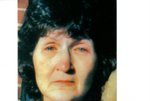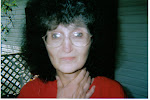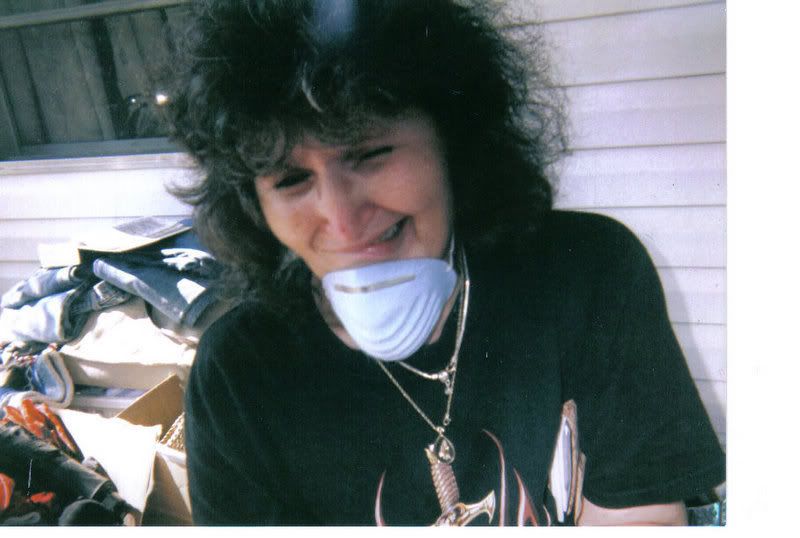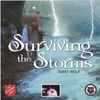Hello all:
This was written and sent to me by my friend, Sharon Kramer. She has done a lot to speak out behalf of mold victims. We have got to have people who will tell the truth. Tlee and I are victims of massive t2 and mold poisoning; yet even since genetic confirmation by pcr and a biopsy Drs. in Augusta, Ga. will not acknowledge our pain or great loss. The physicians ridiculed me when I had severe burns to eyes, nose, face..interstitial lung disease, cyst on spleen and ungodly pain. They refused to run a toxic screen as I requested. They have no desire to help us OR learn from our tragedy. I publicly say: "Shame on you. the way we are being treated is inhumane"!!
Grange Insurance has left us to die since Jan. 2006 when we gave them our reports we in good faith. I even contacted their CEO for we are suffering and except by God's grace dying. This is wrong. I doubt their clients have any idea they'd be so heartless. It angers me when they look at us and try to tell us this did not take place. We certainly did not imagine the last 3 and a half years of our lives. We did nothing to bring this upon ourselves. Grange - tell the world how you are treating us. you'll do others the same way.
Please pray for me and Tlee and send any media, medical or people harmed by mold to us. Thanks to Sharon and Carl for the article. God bless and have a good New Year! iris 706 595 7620 Let's break the mold of greed, deceit and death. Help us PLEASE!
November 2006
Breaking the Mold: Kramer vs. CorruptionCarl GrimesPresidentHealthy Habitats
Denver, Colo.
Sharon Kramer has become one of the more active participants on the Yahoo! IE Quality discussion board, much to the outspoken chagrin and outrage of a few and the background cheers of others. Her basic complaint is quite simple: Despite increasing evidence to the contrary, the courts, public health and mainstream Western medicine have taken the position that severe and debilitating health effects from indoor exposure to mold is not plausible.
Her investigations have led her to what she claims is an intentional campaign by the principal drafters of the American College of Occupational and Environmental Medicine “Evidence-based Statement” of Oct. 27, 2002, “Adverse Human Health Effects Associated with Molds in the Indoor Environment.”
IE Connections: Sharon, what do you mean by “not plausible”?
Sharon Kramer: It’s not what I mean. It’s what the ACOEM means. They are the ones that are making the claim of “not plausible.”
IEC: Okay, so what does the ACOEM mean by “not plausible”?
SK: They mean by “not plausible” or “implausible” as “highly unlikely at best, even for the most vulnerable of subpopulations.” Specifically, they are claiming that their review of the scientific literature leads them to deduce that it is implausible that mycotoxin exposure within an indoor environment could ever reach a threshold level that would cause human illness.
IEC: What is wrong with that? That’s what I’ve been hearing for several years now.
SK: What is wrong with it is that this position is not based on science or a review of scientific literature by any stretch of the imagination. None of the 40 papers cited within the toxicity section of their report make[s] this conclusion. No other document before or since the ACOEM mold statement purports to be able to make this conclusion. No other experts that I have read or talked with before or after the ACOEM statement even implies that conclusion.
IEC: If none of the papers that are the basis of the ACOEM mold statement makes the “not plausible” conclusion, then where did it come from?
SK: It did not come from any of the studies supposedly being reviewed. The authors of the ACOEM mold statement reached the conclusion all on their own.
IEC: Again, I don’t see a problem. Did the research they conducted meet contemporary scientific standards?
SK: That’s one part of the problem. The authors did no scientific research on their own. Instead, they selected a single rodent study conducted by other researchers and, after the fact, applied mathematical calculations to the data. Then, while referring to the original study, they state, “The preceding calculation suggests lower bound estimates of airborne S. chartarum spore concentrations corresponding to essentially no-effect acute and subchronic exposures.”
IEC: I’m confused. Which calculation are you referring to – the original or their retroactive calculation?
SK: I am referring to the ACOEM mold statement authors’ math calculations. No calculations within the supposed reviewed papers make the findings of “not plausible.” ACOEM is the one that is making the claim. And they word it in such a way that it appears the conclusion is based on the calculations of the original study. So, I went back to the original study, and it made no such calculation or claim. I looked through all of the papers being reviewed. None make[s] that claim. In fact, the concluding sentence of the study that the authors’ chose to base their math upon, reads quite to the contrary to what the authors claim to have scientifically concluded. The ending sentence of the foundation study reads: “The consequences of low-level chronic exposure remain to be investigated, as does the relevance of the rodent data to human exposure.”
It is the later calculations, retroactively applied by the ACOEM authors, that [are] the basis for their conclusion of “not plausible.” That is it. Nothing else.
It takes a careful reading to detect the intentional interweaving of evidence. Most doctors just trust the conclusion because it is coming from a reputable medical academy. Defense lawyers and defense expert witnesses tend to take it at face value for the same reason. No one has carefully analyzed the two documents to detect the subtle subterfuge.
IEC: I want to go back to another phrase you used in your first statement of the problem. The phrase, used as a qualifier, was “within an indoor environment.” Is that your phrase or theirs?
SK: That qualifier is used by ACOEM. They don’t refute that mycotoxin exposure sufficient to cause illness in humans is possible. Extremely high levels have historically occurred in agriculture and with foods. But ACOEM concludes, based on their calculations, that it is not plausible that humans can be exposed to enough mycotoxins within an indoor environment to cause illness.
In other words, the determining factor of causation is the location of the exposure.
IEC: Your statements on the IE Quality group have alluded to a connection to the tobacco industry and the methods they used quite successfully for years. Are you claiming the same tactics are being used in the debate about health effects from mold exposure?
SK: Absolutely. The tobacco industry tried to limit proof of causation by attacking and distorting scientific studies. Also, they funded research and reports to defer and distort factors other than secondhand smoke, such as allergies to cockroach and dust mites, as responsible for health complaints and illness.
IEC: So, it appears that somebody observed the tobacco tactics and adapted them to mold. How did you discover this?
SK: I’ll explain my expertise and my discovery in a moment, but first I want to say that the comparisons are much more than imitation. I have found that some of the people and companies deeply involved with the tobacco defense are now involved with the mold defense.
Further, this is an intentional and very deliberate campaign. But it is not a conspiracy. It’s more of a well orchestrated marketing of a concept that exploits the unwary and the trusting.
IEC: Before we get into those details, how did all this start for you?
SK: My family and I had a two-year nightmare that is all too familiar with an increasing number of people. In 2001, we had a leak in the water line to the icemaker. Our insurer sent to us an untrained and uninsured remediation company. They let the water sit for six weeks before drying it out. Mold grew.
The remediation company had no clue as to how to set up a proper containment area. Instead of repairing our home, their large blowers spread airborne mold spores all over our house. We were living elsewhere during the remediation and knew nothing about water damage and mold. For all we knew, they were doing a professional job. When they said they were finished, the insurer hired a lab that said our home was clear. We moved back in.
IEC: What was that like?
SK: At first, it was great. We were glad to be back home! But after just a few days, we all started having problems. My husband and younger daughter complained of a stuffy nose. No big deal. I am a normal, healthy person but was having difficulty breathing and concentrating, which concerned me. But not as much as what was happening to our older daughter.
She is not a normal healthy person. She has been medically diagnosed with cystic fibrosis and allergic bronchiopulmonary aspergillosis. CF is a potentially fatal illness, often from aspergillosis. She was extremely vulnerable.
IEC: Were her health complaints similar to those of the rest of the family, or were they an intensification of her medical condition?
SK: Both. She had similar complaints such as sinus problems, but also headaches and lethargy. Then, she became more and more ill. During our ordeal, she was hospitalized three times and had sinus surgery. I was extremely concerned for her, and our doctors were not well educated as to the dangers our home posed for her health. I began doing my own research and asked them about our water damage and mold problem. I was told mold could not be responsible and I should just go home and take some Prozac.
IEC: You mentioned during our phone conversations that you eventually sued the insurance company, the lab and the remediator. Surely, your daughter’s obvious illness helped your case.
SK: Yes and no. Yes, because through the litigation process, it became blatantly obvious her symptoms were resultant from the excessive exposure to Aspergillus within our home. But no, because the increased financial liability from the matter caused the insurer to dig in their heels farther and try to run us through an endurance contest so they would not have to pay as much money for their errors.
Let me tell you how she was treated. She was forced to give her deposition two days after being released from the hospital. She still had an IV PICC line in her arm because she needed an IV drip every two hours.
IEC: What evidence did you have that the remediator, insurer and lab were at fault?
SK: The insurer’s broker or agent selected and sent the remediator and the company collecting mold samples. The remediator did not use proper procedures to prevent cross-contamination. When we asked for the lab report that confirmed the clearance, no one could find even the chain of custody. The person who said she did the testing couldn’t remember being at our house. The additional testing conducted a week after clearance – because we had moved back in and had become aware that something wasn’t right – measured mold levels that were twice as high as the initial testing used as the basis for remediation.
IEC: How did your case turn out?
SK: We had never been in litigation before and have never thought the courts were the best route to resolve problems. So, we continued trying to work with our insurer. After nearly a year with no progress, they sued us for not accepting a $30,000 settlement. We had to get an attorney and we countersued. Our two-year nightmare finally concluded with a confidential settlement from all three parties.
IEC: How is your daughter now?
SK: We are all better, and she is much improved. But I had to find a fungal specialist before we found treatment that helped. That was a considerable expense because he was outside of our HMO and we had to travel a considerable distance to another part of the state.
But the greater cost was the degradation at the hands of the traditional medical community. It was an inexcusable insult to an already devastating injury.
IEC: How did you decide to become an advocate? Caring for yourself and your family is one thing, but taking on an entire industry complex is quite another.
SK: While going through our nightmare, I began researching and communicating with others who were experiencing much the same thing. As I heard the stories of those that were having much greater struggles, I came to understand that we had been quite lucky. We had a strong marriage, wonderful children, lots of supportive friends and family, and the financial means to weather the storm. I came to appreciate that if they could wreak such havoc on our family, what damage were they capable of against those less fortunate?
I had no intention of becoming a long-term advocate, but I knew I had to do something. If I just walked away after learning what I knew, I would be just as guilty as those that had mistreated, misled and harmed us.
IEC: Is that when you went to Washington, D.C.?
SK: Yes. In the summer of 2004, my intent was to go to D.C. with other advocates, tell our legislators what was occurring – because surely they just didn’t know – and then walk away. We went to D.C. We told our legislators our experiences. They did nothing.
[Kramer participated in a press conference on Sept. 22, 2004, calling attention to this topic. The conference also brought human rights advocate Bianca Jagger to the Rayburn House Building at the conference, organized by the staff of Rep. John Conyers Jr. (D.-Mich.)]
IEC: You said earlier that you would tell us your expertise and discovery. Is this when you learned the science necessary to understand the ACOEM statement?
SK: My expertise is not science, and it isn’t the science I’m questioning. That is best left to the scientists. But many assume I’m attacking the science, so they attack me with statements that I’m just a victim that wants revenge, I have no scientific credentials, so I have no right to speak. They want me to just shut up and go away.
I don’t make scientific claims, and I don’t evaluate the science itself. What I evaluate is the marketing and spin within the ACOEM statement, how the document is being used and the verification of sources.
I have a marketing degree with graduate level training from NCR Corp. and 25 years of experience. I have learned how to verify claims within documents by tracking them back to the original reference. Unscientific or unsubstantiated claims and spin sentences are revealed when they cannot be verified by the expressed or implied source.
IEC: What has your training and experience revealed about the ACOEM statement?
SK: I have read thousands of newspaper articles, court documents and peer-reviewed papers regarding the mold issues. While the vast majority of documents are indicative that mold is causing some very serious health and financial ramifications, there is a strain of documents authored by a small number of the same names that take the opposing view.
They characterize their work as position statements derived from a critical review of documents written by thousands of members of medical associations. Therefore, they carry great weight with busy doctors who trust their authoritative sources. Defense lawyers and expert witnesses appreciate the authoritative support of their position.
These types of documents, written by the same small group of people, are not derived from a broad base of scientific literature. They all rely on the ACOEM conclusion derived from a retroactive math calculation, and are usually written by several of the very same people who wrote the ACOEM statement.
IEC: Are there clues that help initially identify potential spin that should be subjected to closer scrutiny?
SK: Once you know what to look for, they become easier to find. They project themselves as the last word, state of the art, the result of extensive research. They tend to [imply] that what they promote is sound science and others with different conclusions are junk science. They tend to be very aggressive in their intent and manner of writing.
Their citations are by and large other review papers. But even when they cite actual studies, they tend to pull out key phrases they find beneficial and oftentimes disregard the true focus of the paper cited.
Legitimate papers with verifiable sources tend to look at actual studies to form their conclusions. They more readily note the shortcomings of where more research is needed. They do not call out specific papers as junk science. They are not aggressively promoting one school of thought. These types are science. They others are courtroom defense.
IEC: You have made some very strong statements. What is the basis for your claims, especially that they are intentional rather than appear intentional?
SK: The e-mails from when the statement was drafted were subpoenaed and are in court transcripts. I have read them. I have read how this ACOEM document is being used by defense attorneys and expert witnesses in the courtroom as a scientific finding that these illnesses are not plausible. I have read medical documents with the “not plausible” claim based solely on the ACOEM statement. Within the courtroom, the finding of “not plausible” often gets translated to “could not be.”
According to subpoenaed e-mails from the overseer of the peer review process, it had been decided during the drafting of the document that the ACOEM statement would be a defense argument. The ACOEM brought into their organization a former Phillip Morris expert witness for the defense and his business partner to write the toxicity section. Both have a Ph.D. but not an M.D. or other medical public health degree. Neither has experience diagnosing and treating people nor do they have a laboratory background in mycotoxin research. Yet they are quite adept at creative math and experience defending Big Tobacco.
The UCSF Tobacco Legacy Library and the recent RICO [Racketeer Influenced and Corrupt Organizations Act] case against Big Tobacco [United States v. Philip Morris USA] reveal the deceit and marketing used. Similar techniques by some of the same people were used to write the ACOEM statement of Oct. 27, 2002, and subsequent position papers.
IEC: Have you compared the ACOEM position with the National Academy of Science’s Institute of Medicine report “Damp Indoor Spaces and Health”? As a governmental body, they would carry quite a bit of authority.
SK: Yes, I have, and the contrasts are astounding. In addition to the above noted selection process, tone, and lack of accusations that contrary opinions are junk science, the IOM contains these concise statements:
In vitro studies, as explained below, are not suitable for human risk assessment. Risk can be extrapolated from animal studies to human health effects only if chronic animal exposures have produced sufficient information to establish no-observed-adverse-effect levels (NOAELs) and lowest-observed-adverse-effect levels (LOAELs). Extrapolation of risk exposure from animal experiments must always take into account species differences between animals and humans, sensitivities of vulnerable human populations, and gaps in animal data.
The ACOEM statement does exactly what IOM says is not suitable.
Except for a few studies on cancer, toxicologic studies of mycotoxins are acute or short-term studies that use high exposure concentrations to reveal immediate effects in small populations of animals. Chronic studies that use lower exposure concentrations and approximate human exposure more closely have not been done except for a small number of cancer studies.
The ACOEM statement uses a single rat study with a conclusion that includes low-level, long-term exposure not related to cancer. Two years later, the IOM report says no such studies have been conducted.
Thus results of animal studies cannot be used by themselves to draw conclusions about human health effects.
The ACOEM statement uses an animal study by itself – a single study no less, rather than a body of science – and they do draw a conclusion about human health effects, that they are not plausible.
Even more egregious is the promotion of the ACOEM mold statement as consistent with the IOM “Damp Indoor Spaces and Health” report.
IEC: What last words would you like to leave with our readers?
SK: Mold is not the problem I’m fighting. The manner in which the mold issue is being addressed is the problem. Those defensors, who intentionally stifle the progress of science, are the root cause of the contention and confusion over the issue. Their actions fuel the misunderstanding, the fear from both the physical and financial aspects and keep this issue in the courts where the defensors generate the most income. They actually increase the costs to those they are hired to protect by obstructing timely and appropriate medical care that will eventually catch up with them in the form of greater court awarded damages. That’s what happened with exploding gas tanks on cars and to Big Tobacco.
The way to solve this problem is to train the physicians how to recognize, diagnose and treat mycotic diseases so that the physical damages are lessened by early detection and treatment. But we first must dispel the unscientifically founded myth that serious illness is not plausible from excessive exposure to mold within an indoor environment. It may be not yet determined, but that is not the same as not plausible.
IEC: One last question, Sharon. What if the ACOEM calculations and conclusion eventually prove to be correct?
SK: Great! But that’s the point. They haven’t been. Should someone choose to, it could be done quite simply by subjecting the ACOEM conclusion to the appropriate scientific scrutiny afforded any other scientific or medical claim. Until it has been independently challenged and verified, it should not be granted a status any greater or less than any other working hypothesis.
But, again, my point is that nothing justifies the marketing a litigation defense argument disguised as science. The serious harm from propagating misrepresented and distorted scientific facts is not limited to the victims who are turned away. It corrupts and violates the most basic trust for the professionals we rely on for life-and-death decisions.
Carl Grimes is president of Healthy Habitats LLC, an indoor-environmental consulting firm in Denver, Colo. He is the author of the book “Starting Points for a Healthy Habitat” and serves on the Editorial Advisory Board of IE Connections. Grimes can be reached by e-mail at grimes@habitats.com or by phone at (303) 671-9653.
Subscribe to:
Post Comments (Atom)













No comments:
Post a Comment